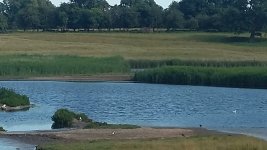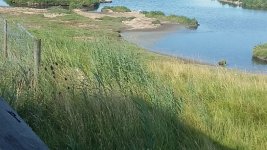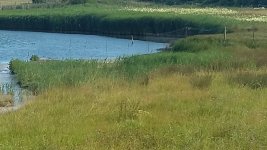Phil Andrews
It's only Rock and Roller but I like it

Habitat management at the Flashes
One "advantage" of so long between visits is that changes are a little more obvious rather than incremental. I left the Flashes today with two main observations.
(1) Overall the water levels were OK given the conditions (another week of weather like this may change that!!). However the lack of dredging in the channels - particularly the "keyhole" on the foreshore and the "delta" to the right of the hide - means that prime feeding areas are either dried out or turned to a thick sludge. Should consent be granted by the Trust / Natural England this now probably requires a mechanical solution rather than doing it by hand.
(2) Our old friend the reedbeds! Views into the third Flash are now totally lost with the two reedbeds virtually meeting at the former beach area between the second and third Flashes. However, of even greater concern was two blocks of reed - not isolated stems - now on the foreshore; one to the left of the hide and the other to the right which is spreading from the secondary fox fence into the delta. Not only will this see the degradation and forthcoming loss of these channels as feeding areas for both passage birds and family parties but it will also create a barrier preventing the viewing of other areas. Again the encroachment has gone too far to attempt to tackle by handle - if chemical treatment is not permitted then again a digger is required to take out a significant chunk of ground to capture all the rhizomes. This may be a bit brutal and ugly and require some reshaping of the foreshore but it will be the old way to remove this over-growing threat.
One "advantage" of so long between visits is that changes are a little more obvious rather than incremental. I left the Flashes today with two main observations.
(1) Overall the water levels were OK given the conditions (another week of weather like this may change that!!). However the lack of dredging in the channels - particularly the "keyhole" on the foreshore and the "delta" to the right of the hide - means that prime feeding areas are either dried out or turned to a thick sludge. Should consent be granted by the Trust / Natural England this now probably requires a mechanical solution rather than doing it by hand.
(2) Our old friend the reedbeds! Views into the third Flash are now totally lost with the two reedbeds virtually meeting at the former beach area between the second and third Flashes. However, of even greater concern was two blocks of reed - not isolated stems - now on the foreshore; one to the left of the hide and the other to the right which is spreading from the secondary fox fence into the delta. Not only will this see the degradation and forthcoming loss of these channels as feeding areas for both passage birds and family parties but it will also create a barrier preventing the viewing of other areas. Again the encroachment has gone too far to attempt to tackle by handle - if chemical treatment is not permitted then again a digger is required to take out a significant chunk of ground to capture all the rhizomes. This may be a bit brutal and ugly and require some reshaping of the foreshore but it will be the old way to remove this over-growing threat.







